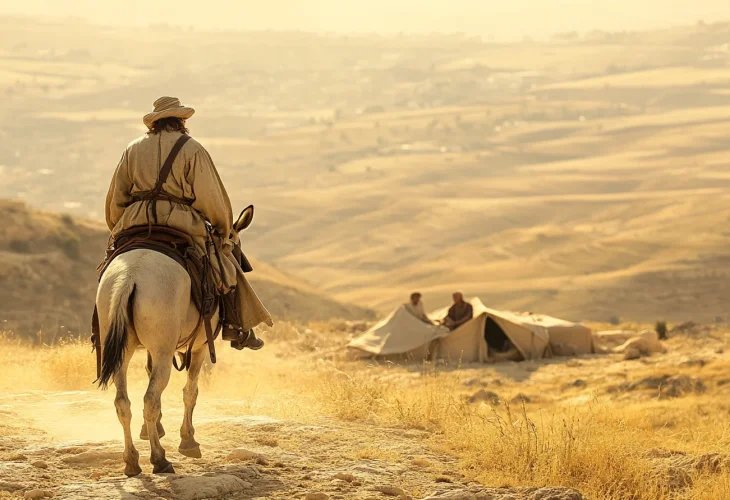Torah Personalities
Rediscovering Ancient Israel: The Remarkable Journey of Rabbi Estori HaParchi
How a 14th-century Jewish scholar mapped the land of Israel and laid the foundation for our contemporary understanding of biblical Israel

A Curious Stranger on a Hilltop
In the summer of 1300, a curious scene unfolded in the Beit She'an Valley. Under the scorching sun, an elderly Jew dressed in French garb slowly made his way up a desolate, ancient mound, riding a weary donkey. When he arrived at a local Arab encampment, he bypassed the expected pleasantries and quickly sought out the tribe's elder. The locals assumed he had come to negotiate livestock deals or arrange a marriage, but they were taken aback by his peculiar request: he wanted to know the historical name of the place.
The elder, after some reflection, recalled hearing from his grandfather that this place had once been called "Al-Rahba." The visitor's face lit up. He leapt to his feet, thanked his hosts, placed a coin on the table, and departed with a glow of satisfaction.
That visitor was Rabbi Estori HaParchi (also known as Ashtori HaParchi), one of the earliest Jewish researchers of the Land of Israel and a prominent Torah scholar during the Tosafists era. He spent seven years traversing the land, from ruins to springs of water and cities to ancient mounds, documenting names, landmarks, and traditions, which he later compiled in his monumental work, Kaftor VaFerach.
Mapping the Holy Land Through Memory and Halacha
The mound he ascended is today known as Tel Rehov, the site of the ancient city of Rehov mentioned in the Bible. Rabbi Estori was the first to realize that many Arabic names preserved the ancient Hebrew ones from the era when the Jews lived in the land. The Arabic name "Rahba," he inferred, was likely a linguistic echo of the biblical "Rehov," which the Jerusalem Talmud mentions as being near Beit She'an.
In his explorations, Rabbi Estori found a rare ancient Israelite coin at the site and studied it meticulously. He wrote: "I came upon a dinar from the Shekel HaKodesh (sacred shekel), with Hebrew letters in Kuti script, one side depicting a censer and the other an almond tree with three blossoms. I weighed it carefully, and it came to four and a half dirhams and one qirat. From this I calculated the Torah's sela (coin weight) relative to the Canaanite dirham."
Centuries later, archaeologists unearthed a synagogue at the same site containing the famous "Rehov Inscription," a detailed record of halachic (Jewish legal) rulings on agricultural laws during the Sabbatical year, organized by geographic zones. The site has also yielded inscriptions with the names "Elisha" and "Nimshi," both tied to the biblical stories of the prophet Elisha and King Jehu, whom Elisha instructed to anoint as the King of Israel.
Whenever Rabbi Estori encountered the Jordan River, he would stop to recite a special prayer of thanksgiving: "By the Jordan I will bless, I will praise and thank Your name, for Your people You brought through it as You did the Red Sea." His love for the land of Israel permeated every step of his journey. He once wrote, "It is worthy to visit and circle these holy places even in our times, for surely they still retain something of their original sanctity."
From Exile to Exploration: A Life Shaped by Tragedy and Torah
Rabbi Estori HaParchi was not born an explorer. He was born in France during a time of severe persecution. His father, Rabbi Moshe, was martyred al kiddush Hashem (in sanctification of Hashem's name). Estori himself was expelled during the 1290 expulsion of French Jewry and recounted his experience: "They dragged me from my school, stripped me of my cloak, and clothed me in exile. From my father's home and birthplace I left naked, a youth wandering from nation to nation, from kingdom to people whose tongue I did not know. I found no rest until the King of Peace brought me to His chambers, from captivity to the Land of Israel, His holy land."
He eventually reached Barcelona, where he studied medicine, Latin, astronomy, and Greek philosophy. From there, he sailed to Egypt, met Rabbi Shmuel HaNagid (a descendant of the Rambam), and was deeply influenced by him. Estori later moved to Jerusalem, but due to intense controversy over the Rambam's writings at the time, he relocated to Beit She'an.
There, he overheard some Jews claiming that Beit She'an lay outside the halachic boundaries of the Land of Israel and thus lacked its sanctity. Disturbed by this, he began a deep investigation of the Torah and rabbinic sources regarding the biblical borders, cross-referencing them with geographic features and local oral traditions. This research became the basis for Kaftor VaFerach, a landmark work in halachic geography and Jewish heritage.
Legacy of a Seeker
Though the book was not widely known in his lifetime due to geographic isolation and the times' harsh realities, it later gained recognition as a foundational work for scholars and halachic authorities. Some even speculate that his name, "Estori," was a literary pseudonym, "Ish Tori," meaning "the man who explored."
The exact time and place of his death remain unknown. But his words are his legacy. His writings serve as a bridge between past and present, carrying the spiritual topography of the Jewish people through exile, memory, and return. They remind us that every footstep on this sacred land has a story, and every name holds echoes of ancient voices waiting to be recalled.

